Abstract
Objectives:
Although directional microphones on a hearing aid provide a signal-to-noise ratio benefit in a noisy background, the amount of benefit is dependent on how close the signal of interest is to the front of the user. It is assumed that when the signal of interest is off-axis, users can reorient themselves to the signal to make use of the directional microphones to improve signal-to-noise ratio. The present study tested this assumption by measuring the head-orienting behavior of bilaterally fit hearing-impaired individuals with their microphones set to omnidirectional and directional modes. The authors hypothesized that listeners using directional microphones would have greater difficulty in rapidly and accurately orienting to off-axis signals than they would when using omnidirectional microphones.
Design:
The authors instructed hearing-impaired individuals to turn and face a female talker in simultaneous surrounding male-talker babble. Participants pressed a button when they felt they were accurately oriented in the direction of the female talker. Participants completed three blocks of trials with their hearing aids in omnidirectional mode and three blocks in directional mode, with mode order randomized. Using a Vicon motion tracking system, the authors measured head position and computed fixation error, fixation latency, trajectory complexity, and proportion of misorientations.
Results:
Results showed that for larger off-axis target angles, listeners using directional microphones took longer to reach their targets than they did when using omnidirectional microphones, although they were just as accurate. They also used more complex movements and frequently made initial turns in the wrong direction. For smaller off-axis target angles, this pattern was reversed, and listeners using directional microphones oriented more quickly and smoothly to the targets than when using omnidirectional microphones.
Conclusions:
The authors argue that an increase in movement complexity indicates a switch from a simple orienting movement to a search behavior. For the most off-axis target angles, listeners using directional microphones appear to not know which direction to turn, so they pick a direction at random and simply rotate their heads until the signal becomes more audible. The changes in fixation latency and head orientation trajectories suggest that the decrease in off-axis audibility is a primary concern in the use of directional microphones, and listeners could experience a loss of initial target speech while turning toward a new signal of interest. If hearing-aid users are to receive maximum directional benefit in noisy environments, both adaptive directionality in hearing aids and clinical advice on using directional microphones should take head movement and orientation behavior into account.
Keywords: Hearing aids, Directional microphones, Head movement, Sound localization
INTRODUCTION
Modern hearing aids often incorporate directional microphones that can provide a substantial signal-to-noise ratio (SNR) improvement—and typically a corresponding speech-intelligibility benefit—over omnidirectional microphones (Bentler 2005). To obtain the maximal benefit, however, requires an ideal set of conditions (Valente et al. 1995): the listening environment should have no more than moderate reverberation (i.e., the level of the direct and reflected sound should be at least equal), the background noise should be at the side or the rear of the listener, and the listener should be more or less facing the signal of interest (Ricketts & Dhar 1999; Hornsby & Ricketts 2007). Thus for signals and noises in a spatially complex environment, the potential benefit of a directional hearing aid is critically dependent on the listener’s head already being pointed in the correct direction. The typical assumption is that a listener using directional hearing aids in a complex environment such as a restaurant will simply orient toward each signal of interest in turn. This study examines how capable listeners are of this orientation movement.
On-axis listening with directional microphones (i.e., with the head pointed at the signal source) has been shown to increase intelligibility relative to omnidirectional microphone listening (for a review, see Ricketts & Dittberner 2002). This difference is termed the directional benefit. In addition to the increase in intelligibility afforded by correct head orientation while using directional microphones, orientation of the head to a sound makes it easier to see cues such as lip movements that have been shown to aid speech detection (Grant & Seitz 2000; Grant 2001) as well as speech intelligibility (MacLeod & Summerfield 1987; Middelweerd & Plomp 1987). Modest off-axis orientation still results in directional benefit: speech intelligibility can increase for signals up to 30° off-axis when using directional microphones (Ricketts 2000; Henry & Ricketts 2003). But when the angle between the listener and signal of interest is larger than about 60°, depending on the directional pattern, intelligibility drops substantially below omnidirectional performance. This is a directional deficit. Fully off-axis orientation between 90 and 135° leads to dramatic directional deficits in word recognition scores in quiet as well as decreases in pure-tone detectability (Kuk et al. 2005).
Given that head angle can result in a loss of intelligibility and detectability, it is important that a listener be able to orient themselves with respect to signals of interest. In order for this to be possible, however, listeners must first be capable of determining the direction of the signal. Hearing impairment is associated with a decrease in the accuracy and consistency of localization judgments (Angell & Fite 1901; Tonning 1975), particularly in the presence of background noise (Lorenzi et al. 1999). The use of hearing aids can improve localization, but any benefit is highly dependent on the user’s type and degree of hearing loss, mould-type, and fitting procedure (Byrne et al. 1992), with completely-in-the-canal aids offering a better localization benefit (Best et al. 2010). Discrimination of front/back location can be improved with directional microphones, as the front-back level difference caused by the directional pattern provides a highly salient cue; for instance, Keidser et al. (2006) found front/back discrimination was significantly better with directional microphones than with an omnidirectional fitting. Directional microphones, in contrast, have not been shown to improve general localization ability; the same study found that mean left/right error was equivalent across omnidirectional and directional modes. Van den Bogaert et al. (2006) showed that users of bilateral behind-the-ear hearing aids performed worse when using adaptive directional microphones than when using omnidirectional microphones. In favorable conditions of +10 dB SNR, Chung et al. (2008) found that directional microphones did not degrade localization performance and helped hearing impaired (HI) listeners localize sounds from the rear both in quiet and in noise.
Because directional microphones and head orientation necessarily interact with each other, it is important to know whether and how hearing aid wearers using a directional program orient themselves to a signal of interest. While localization errors in orienting tasks have been previously characterized, the head movements used by hearing aid users remain unstudied. Furthermore, while it has been shown that head movements increase the accuracy of sound localization (Noble 1981; Perrett & Noble 1997a, 1997b), contribute to resolving front/back confusion (Wightman & Kistler 1999; Brimijoin & Akeroyd 2012), and play a role in auditory externalization (Brimijoin et al. 2013), it is unclear how hearing aids interact with these movements.
The purpose of the present study was to examine the head movements of bilaterally fitted HI listeners in both omnidirectional and directional modes while undertaking an orientation task. We expected that performance in omnidirectional mode would be similar for on-axis and off-axis signals. Conversely, given the large drop in audibility associated with off-axis listening in directional mode, we expected to observe dramatic changes in the complexity and duration of head orientation movements with listeners using the directional mode.
MATERIALS AND METHODS
Apparatus
Participants were seated in the center of a circular 24-loudspeaker (Phonic Sep207) ring with a 0.9 m radius in a sound-dampened chamber. Sound presentation was controlled in Matlab using a MOTU 2408 Mk3 and a set of three 8-channel Fostex DA converters. The dB (A) level of each loudspeaker was calibrated to within 0.5 dB at 1 kHz using 80 dB pink noise.
Motion tracking was performed using an infrared camera system (MX3+; Vicon, Los Angeles, CA) using methods described previously (Brimijoin et al. 2010). A set of six cameras tracked 9 mm diameter reflective spheres; these markers were placed on four of the loudspeakers (at angles of 0°, −90°, +45°, and +90°), a head-mounted “crown” worn by the listeners and a wand. The loudspeaker markers provided reference directions, and the wand was used to determine the location of the ears and nose relative to the crown. A custom Matlab program recorded three-dimensional Cartesian coordinates of all markers on all objects at a sample rate of 50 Hz. Subsequent coordinate translation and rotation allowed us to determine the orientation of the listener’s head relative to the loudspeaker ring to within 0.1° regardless of the placement of the crown on the head.
Following standard measurement techniques (ANSI 3.22 1997), the directionality of the experimental hearing aids was measured in situ using a ½″ reference microphone (GRAS, Holte, Denmark), preamp (GRAS), and Zwislocki coupler mounted in a manikin (KEMAR) with artificial pinnae. The manikin was rotated in 10° increments using a stepper-motor turntable (LD360; LinearX, Tualatin, OR) at a distance of 1 m from the face of a loudspeaker (JBL Control 1G) in a sound-dampened chamber. Responses to swept sinusoids were measured using a time-window approach (Listen Inc. SoundCheck, Boston, MA) and smoothed with a three-point sliding Gaussian window to offset any potential distortions due to the reflections of the room. A modified version of the Articulation Index-weighted Directivity Index (AIDI) was used as a measure of the directional performance of each participant’s hearing aids (Ricketts & Dittberner 2002), although it should be noted that our directional measurements were only made in the horizontal plane unlike more complete characterizations found elsewhere (Dittberner 2003). To compute the AIDI, first the frequency-specific directivity indices were computed as the ratio of power at 0° to the average power off-axis (10°–350°) for each third-octave band. These values were then weighted by the Articulation Index in third-octave bands from 250 to 6300 Hz and averaged (Mueller 1990). Because the measurements were made in situ on a manikin, the accompanying head shadow resulted in responses different from conventional free-field AIDI measurements. We thus refer to our directivity measurements as In-Situ Directivity Index (ISDI). ISDI values were computed for both the omnidirectional and directional settings of each hearing aid.
The directivity patterns from a representative hearing aid were used to estimate the SNR that a listener would experience as their head turned during a simplified version of the orienting task. For this computation, we used a noise source at +60°, a signal source at +120°, and a 3.5 sec sigmoidal orientation movement from 0° to +120°. Directivity patterns for both omnidirectional and directional microphones were used to determine the Articulation Index (AI) weighted level of the signal and noise source in turn as a function of head angle over time. This process yielded the AI-weighted SNR that would be experienced as a function of time over the course of the orienting movement.
Stimuli
The listeners were presented with a background babble of voices. This babble was composed of ongoing concatenated male-talker sentences from the IEEE corpus (Rothauser et al. 1969). Six different male talkers were used, one for each of the six noise locations; these locations were fixed at ±30°, ±90°, and ±150° relative to the participant’s head angle as measured at the start of each trial (Fig. 1). The reasons for the specification of these locations with respect to the head rather than with respect to the 0° loudspeaker, an arbitrary point to which the listeners were asked to reorient after each trial, were that (1) the time involved in reorienting would unnecessarily lengthen the experiment time and (2) listeners are never particularly accurate in orienting. By presenting targets relative to the head we ensured that we could measure the head movements associated with a particular (and repeatable) angular offset relative to their starting positions. To present sounds from angles that were between two loudspeakers, we used equal-power panning based on a sine/cosine crossfade between the two nearest loudspeakers. The signals consisted of concatenated female-talker sentences from the BKB corpus (Bench et al. 1979). Signal position on each trial was also specified relative to the participant’s head angle at the beginning of the trial: signals were presented from 45° to 150° relative to the listener’s acoustic midline in 15° increments. These locations were repeated eight times each, and the order of all trials was randomly shuffled. The first signal in a block began 5 sec after babble started; this was to ensure that any long-term (slow attack) compression in the hearing aids was engaged before the start of the signal. Signal duration was determined by the participant; a 50 ms cosine2 onset gate was applied to each signal, and when the participant pressed a button (see later) to signal when they were facing the target signal the corresponding offset gate was applied. The long-term average level of the babble measured at the center of the ring was 59 dB (A). The long-term average signal level was 65 dB (A), so the average SNR was +6 dB.
Fig. 1.
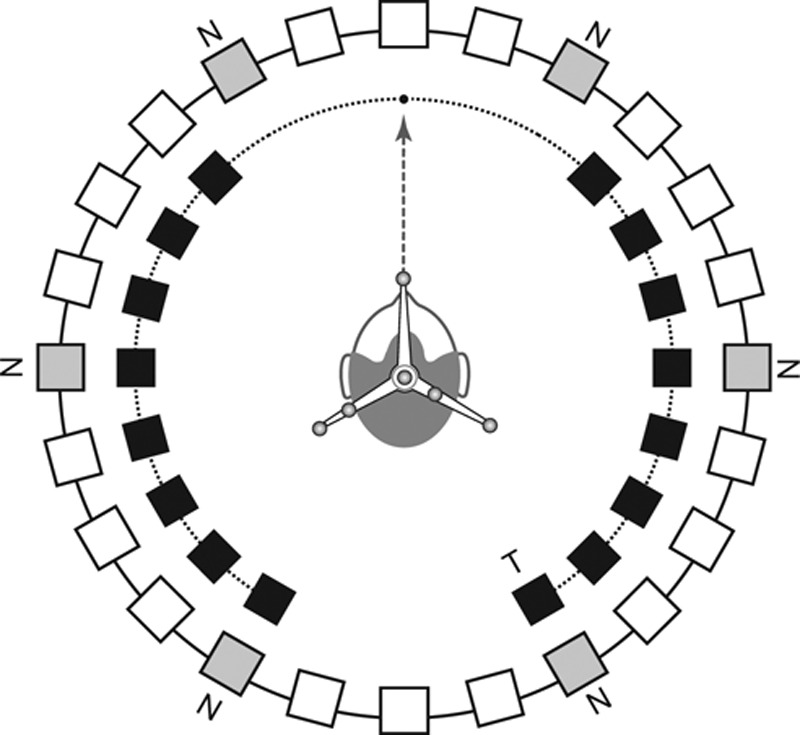
Schematic of presentation method showing noise locations (N) and possible signal positions (black boxes). On each trial, six noises and a signal anywhere from ±45° to 150° were presented. All stimuli were positioned with respect to the head angle (azimuth) of the listener at the beginning of the trial.
Procedure
Participants were instructed to continually listen for, and orient their head to, the female voice (i.e., the signal) regardless of the locations of the male talkers (i.e., the babble). Participants were told to press a key on a small wireless numeric keypad in their hand when they considered their head to be aligned with the target signal position. The next trial began 250 ms after the previous trial (i.e., after the button was pressed) to avoid resetting any adaptive hearing aid processing. Participants were randomly selected to first perform the experiment either in directional mode or in omnidirectional mode. The mode selection in both devices was verified for each block by an experimenter. Between directional and omnidirectional trial blocks, the listener was given a short break during which the microphone response of the hearing aids was measured.
Participants
Full data sets were recorded for 15 listeners. All participants were fitted bilaterally with hearing aids at least 6 months before testing. All listeners reported that they were aware of their devices had multiple programs but were not asked to estimate their experience with each program. All hearing aids were programmable dual-microphone behind-the-ear devices from various manufacturers (Microtech, Phonak, GN ReSound, and Siemens). In order not to tamper with each listener’s hearing aid and to ensure we knew the precise settings of each, we replicated each listener’s exact gain structure and compression settings on a new device of the identical make and model. We then programmed these experimental hearing aids to have program one set to omnidirectional mode and program two to non-adaptive directional mode. Listeners used their own hearing-aid moulds.
Statistical Analysis
Based on measurements of the directionality of their hearing aids (while set to directional mode), the subjects were separated into two groups for data analysis: low directionality (n = 7) and high directionality (n = 8). The cutoff point was an ISDI (see earlier) of 2 dB, which delineated the measured ISDIs into two clusters and conveniently divided the subject pool into similarly sized groups. Figure 2A shows the ISDI and hearing impairment of each listener. The listeners with high-ISDI hearing aids are henceforth referred to as high-ISDI listeners and the others as low-ISDI listeners. The mean omnidirectional and directional polar patterns of the hearing aids for these two groups are shown in Figure 2B. The gains at 0° for both patterns were normalized to a value of 0 dB before averaging.
Fig. 2.
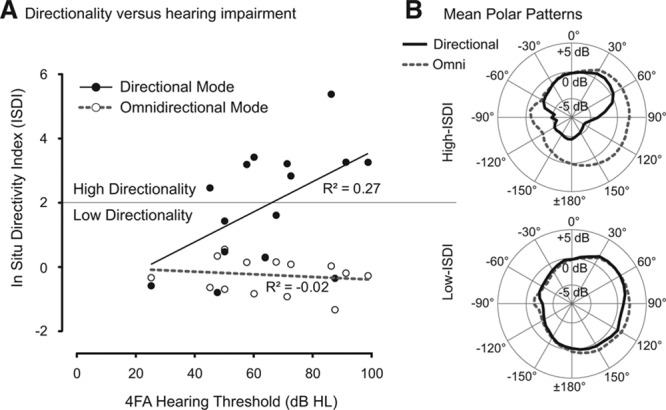
A, In-Situ Directivity Index (ISDI) as a function of hearing impairment in omnidirectional mode (open circles) and directional mode (closed circles). In directional mode, ISDI increased as a function of hearing loss; individuals with greater hearing loss tended to be fitted with devices whose microphones were more directional. B, Mean polar patterns for omnidirectional (dotted line) and directional (solid line) for the two groups of listeners.
Listener’s head movements were most often characterized by a trajectory with a roughly sigmoidal shape, accelerating from rest, reaching a peak velocity halfway through the movement, and slowing upon approach to the target. We analyzed four features of the movement trajectories for both groups: fixation error, fixation latency, trajectory complexity, and proportion of misorientations. Fixation error was defined as the absolute difference in degrees between the target angle and the listener’s head orientation angle at the time of the response-button press. Fixation latency was defined as the time a listener took to complete their movement and indicate they were finished by pressing a button. Trajectory complexity was computed by calculating the root mean square (RMS) difference between each listener’s movement trajectory and a logistic fit to this trajectory (before this curve-fitting, raw trajectories were offset to start at 0°, unfolded in cases where the trajectory exceeded 180°, smoothed with a 0.1 sec Hann window, and sign-reversed as necessary to ensure the net movement was to the right). Trajectory complexity is thus reported in degrees RMS and quantifies the departure of the listener’s trajectory from a simple, sigmoidal trajectory. Note that this method of measuring complexity is different from the polynomial used in our previous study (Brimijoin et al. 2010). The reason for this is that the movement trajectories analyzed in the present study were far longer in duration than the simple orienting responses in our previous work. We found that fitting these long trajectories with a polynomial was more vulnerable to noise than a comparison with a sigmoid. Finally, the proportion of misorientations was defined as the fraction of trials during which the listener initially turned more than 3° in the wrong direction.
All statistical analyses were performed in SPSS 18. We performed separate statistical analyses on low-ISDI and high-ISDI listeners. Each analysis consisted of two-way repeated measures analysis of variance on the main effects of microphone mode and target angle and the interaction between the two factors. In those cases for which the data were nonspherical according to Mauchly’s test, we report the Greenhouse–Geisser adjusted F ratio, p, and degrees of freedom.
RESULTS
Example Trajectories
Figure 3 shows the movement trajectories of an example listener orienting while using omnidirectional microphones (Fig. 3A) and while using directional microphones (Fig. 3B). These trajectories are plotted after the process of unfolding, smoothing, and sign reversal detailed in Section 2.3. The circles indicate the endpoints of the trajectories (the angle values of which are repeated as open circles on the right of each panel). This figure is intended to provide an example demonstrating the average findings for all subsequent analyses described in this section: (1) fixation points (open circles, right-hand side) did not greatly differ between the omnidirectional and directional modes; (2) latency (filled circles at trajectory end points) was longer for listeners using directional microphones; (3) trajectory complexity (overall variability in the lines) was greater when using directional microphones; and (4) listeners using directional microphones more frequently turned in the opposite direction of the target (trajectories dropping below 0°).
Fig. 3.
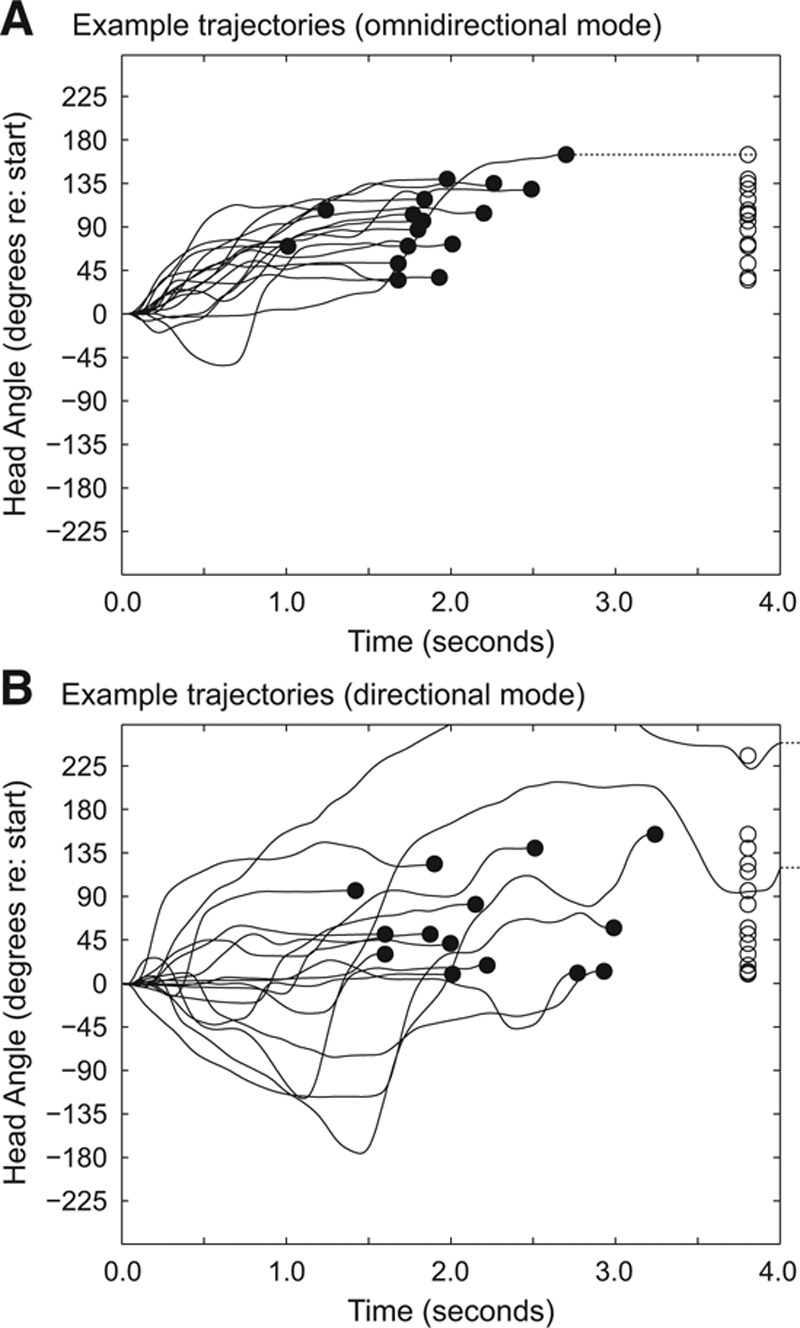
Representative movement trajectories toward a target at +60° while using omnidirectional mode (A) and directional mode (B). Individual lines represent head angle over time and the filled circles represent the endpoints (fixation angle and response latency) of these trajectories. The open circles are the fixation angles replotted to the right to more clearly show their distribution.
Fixation Error
Figure 4 shows the mean fixation error for all listeners as a function of absolute target angle; target angles to the left (negative) were reflected about the zero point and the error values averaged together with the right-side (positive) angles. The fixation error of the low-ISDI listeners (Fig. 4A) was not affected by microphone mode (F statistic and p value for this, and all subsequent analyses are listed in Table 1) but increased significantly as a function of target angle. There was no interaction between microphone mode and target angle.
Fig. 4.
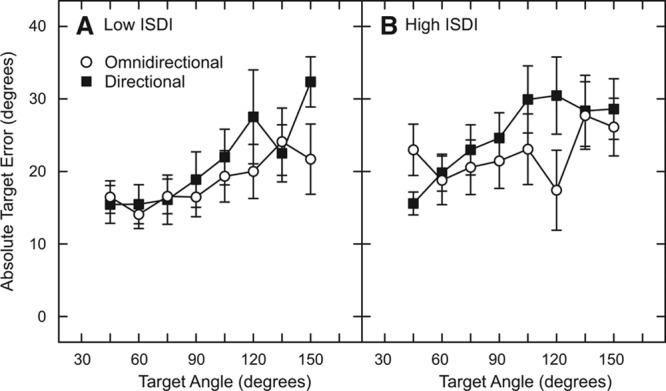
Mean fixation error as a function of target angle for low In-Situ Directivity Index (ISDI) listeners (A) and high ISDI listeners (B). Both groups show an increase in error as a function of target angle for both omnidirectional (open circles) and directional modes (closed squares).
Table 1.
Analysis of variance results

For the high-ISDI listeners (Fig. 4B), there was a significant increase in fixation error as a function of target angle. We found neither a significant interaction between microphone mode and angle nor a main effect of microphone mode. These results suggest that hearing aid directionality has no effect on a listener’s final orienting accuracy.
Fixation Latency
Figure 5 shows fixation latency, the time it took listeners to complete their orientation toward a target, as a function of that target’s angle. Low-ISDI listeners (Fig. 5A) showed a target angle-dependent increase in response latency. There was no effect of microphone mode, nor was there an interaction between microphone mode and target angle.
Fig. 5.
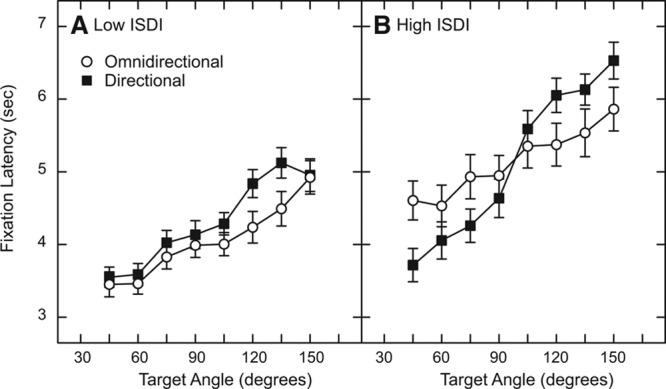
Fixation latency as a function of target angle for low In-Situ Directivity Index (ISDI) listeners (A) and high ISDI listeners (B). Both groups show an increase in latency as a function of target angle for both omnidirectional (open circles) and directional modes (closed squares). The slope of the latency change was larger in directional mode for high ISDI listeners.
For high-ISDI listeners (Fig. 5B), we found no main effect of microphone mode. There was a significant effect of target angle, indicating that listeners took longer to orient toward the most off-axis targets. There was a significant interaction between microphone mode and angle. This suggests that, compared with omnidirectional mode, when using the directional mode of their hearing aids, listeners took less time to orient to nearby targets, but more time to orient to more distant targets. The cross-over in these results was at about 90°, a target angle that corresponded to a rapid dropoff in the directional polar pattern (Fig. 2B).
It should be noted that the mean fixation latency in omnidirectional mode was different (t(104) = 7.69, p < 0.001) across the two groups of listeners (compare the white circles in Fig. 5A versus 5B); this suggests that the two groups were different from one another in some way. This difference may be due to the positive correlation between ISDI and average hearing loss, in that the high-ISDI listeners were also more hearing impaired (Fig. 2). This correlation may be related to the observed across-group differences in the omnidirectional mode results, but this association was not explicitly tested.
Trajectory Complexity
Figure 6 shows trajectory complexity as a function of target angle. For trajectory complexity in low-ISDI listeners (Fig. 6A), we found no effect of microphone mode or target angle, nor did we find a significant interaction effect between the two. This suggests that low-ISDI listeners oriented smoothly and consistently toward a target regardless of the mode of their hearing aids or the off-axis angle of the target sound.
Fig. 6.
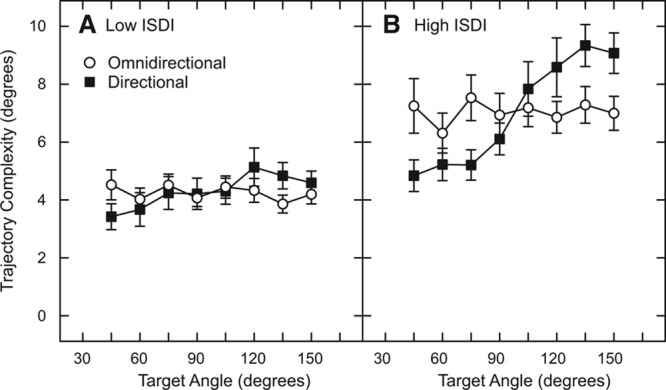
Trajectory complexity as a function of target angle for low In-Situ Directivity Index (ISDI) listeners (A) and high ISDI listeners (B). Only the high ISDI group showed an increase in complexity as a function of target angle and only in directional mode (closed squares), not in omnidirectional mode (open circles).
The results were different for high-ISDI listeners (Fig. 6B). We found a significant interaction between microphone mode and target angle, suggesting that hearing aid directionality affects the smoothness of a listener’s head movements during the process of orienting toward a target sound. We also found a main effect of target angle but no main effect of microphone mode. As with fixation latency, we again observed for omnidirectional mode a substantial difference in average trajectory complexity between the two ISDI groups.
Proportion of Misorientations
There were many trials during which a listener turned initially in the incorrect direction, sometimes taking the long way around the loudspeaker ring to orient to the signal. These misorientations were quantified and plotted as a function of target angle in Figure 7. For low-ISDI listeners, the further off-axis the target, the more likely they were to misorient, but misorientations were not significantly affected by microphone mode. No significant interaction between microphone mode and target angle was found.
Fig. 7.
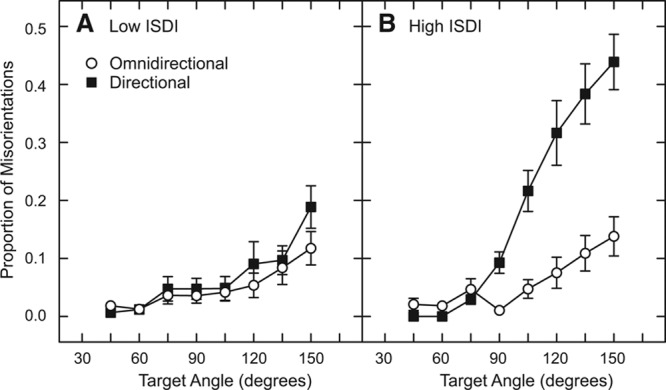
Proportion of misorientations as a function of target angle for low In-Situ Directivity Index (ISDI) listeners (A) and high ISDI listeners (B). Both groups show an increase in misorientation as a function of target angle for both omnidirectional (open circles) and directional modes (closed squares). The slope of the latency change was largest in directional mode for high ISDI listeners.
For high-ISDI listeners, we found significant main effects of target angle and microphone mode. There was also a significant interaction between microphone mode and target angle.
DISCUSSION
Summary of Main Results
Whether the microphone was in omnidirectional or directional mode did not affect orientation behavior in listeners with low-ISDI hearing aids. This is understandable given that this group was defined as those listeners whose hearing aids’ directional mode was no more than 2 dB more directional than its omnidirectional mode (and for two participants, the omnidirectional mode was more directional in situ than the directional mode). As an aside, given that nearly half of our participants arrived with devices that had less than 2 dB of directionality as measured in situ, we believe that audiologists may wish to actually test the directionality of a given hearing aid at the time of dispensing (a suggestion also raised by Bell et al. 2010). The directional mode of a hearing aid should in principle have an ISDI of 3 dB at minimum; to have a smaller ISDI suggests a corresponding reduction in potential SNR benefit. Nevertheless, because we wished to test what effects microphone directionality had on orienting responses, the subsequent discussion will focus exclusively on the group of listeners whose devices had ISDI values greater than 2 dB.
For high-ISDI listeners, the switch to directional microphones was not associated with any systematic changes in a listener’s final fixation angle. This suggests that at the completion of an orienting movement, a listener’s overall orienting accuracy was not affected by the particular microphone mode they are using. In contrast, directional microphones were associated with large changes in the movement phase of orienting behavior, namely the fixation latency and trajectory complexity. The consistent pattern for both is that listeners benefitted from directional microphones for small target angles, but for large target angles directionality was associated with more complex and longer-duration trajectories. The cross-over point for both measurements was around 90°; this is likely related to the substantial drop in audibility relative to omnidirectional microphones that occurred between 60° and 90° (Fig. 2B). Directional microphones were also associated with what appears to be a target-angle dependent linear increase in the number of initial turns in the wrong direction, increasing to nearly half the trials at target angles of ±150°; we believe this is most likely due to a large loss in off-axis audibility.
The Causes of Increased Movement Complexity
We suggest the observed effects of directional microphones on latency and complexity are due to two primary factors. The first is a target angle-dependent change from a simple orienting behavior to a search behavior. For small target angles, directional microphones aid the listener in initiating an orienting turn in the correct direction with a good estimate of the angle of the target sound. Thus in these situations, the movements of listeners are simple, rapid, and accurate in that they require little correction at the end of the trajectory. For very large angles, the listener appears to adopt a search behavior in which he or she turns until the signal of interest is found. The large number of initial misorientations suggests that depending on the polar pattern of the directional microphone, the signal may even be below detection threshold at its onset, requiring a listener to turn in a randomly chosen direction until he or she can hear it. The movement trajectories observed for our directionally aided listeners are not unlike those seen in search-task experiments using ear protection devices such as ear muffs and plugs (Simpson et al. 2005), suggesting that bilaterally fitted directional microphones interfere with the availability of viable spatial cues for off-axis signals of interest. We have previously shown that hearing-impaired listeners exhibited more complex orientation movements to sentences presented in quiet in comparison with normal hearing listeners (Brimijoin et al. 2010). The complex movement trajectories seen with directional microphones in the present study are similar, suggesting that the reversals, accelerations, and decelerations that characterize the movement trajectories for far off-axis angles may be seen as behavior resulting from the listener engaging in a search task rather than an orientation response.
The second potential factor contributing to change in orientation behavior associated with directional microphones is a fluctuation in the SNR during a head turn. We have previously demonstrated that the SNR for spatially separated targets and noises at one ear is dependent on head angle (Brimijoin et al. 2012). In an environment consisting of a signal and multiple sources of noise, directional microphones create a situation in which SNR changes in a complex fashion as a function of head angle. Figure 8 is a plot of the AI-weighted SNR that would be experienced during a sigmoidal orientation movement for a simplified version of the task with a noise source at +60° and a signal at +120°. In this example, the SNR remains relatively constant during head movement when using omnidirectional microphones. For directional microphones, in contrast, when the polar pattern of a directional microphone was swept across the distractor, the SNR decreased dramatically as the listener began to orient toward the signal source, only to subsequently increase again as the listener approached the signal location. Consider a listener turning toward a new signal of interest: a precipitous drop in SNR could suggest to listeners that they were turning in the wrong direction, causing them to initiate a reversal. We suggest that some of the observed complexity in orienting responses is due to the idiosyncratic effect that directional microphones have in complex environments where the SNR is highly dependent on orientation.
Fig. 8.
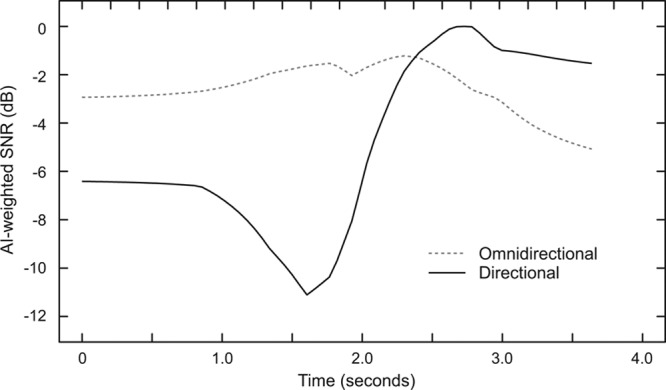
Model results predicting AI-weighted signal-to-noise ratio (SNR) over the course of an orientation movement toward a signal at 120° past a noise at 60°. For omnidirectional microphones (gray dotted line), SNR remains similar as the head turns. By contrast, the use of directional microphones (solid black line) is predicted to be associated with large changes in SNR as a function of head angle. AI, Articulation Index.
A Potential Confound With Hearing Impairment
The amount of directionality for a given device was significantly correlated with the user’s level of hearing impairment (Fig. 2A). It is unknown whether this pattern occurred by chance, given our small sample, or whether there are systematic differences in the directionality of hearing aids supplied to listeners with different levels of hearing impairment. Nevertheless, there exists the possibility that some of the observed behavioral effects were due not to microphone directionality per se but rather a general effect of hearing impairment. While this confound is to some extent intractable given our listener pool, no differences in either fixation error or proportion of misorientations were seen between the low ISDI and high ISDI listeners when using omnidirectional microphones (compare the open circles in Figs. 4A versus B and 7A versus B). If hearing impairment were the sole cause of any observed differences, we would expect to see a difference in performance for both directional and omnidirectional microphones. That said, an upward shift was observed for fixation latency and trajectory complexity (Figs. 5 and 6). The key finding of the study, however, was not that directionality introduced a linear offset in performance, but that microphone directionality introduced an interaction with target angle: performance was better for small target angles and worse for large target angles across a range of metrics. We argue that this change in slope was not induced by hearing impairment but most likely by microphone mode.
Directionality and Behavior
In a realistic auditory environment consisting of a number of sources of noise and a single source of interest, directional microphones can provide an increase in SNR and a corresponding increase in speech intelligibility. This benefit, however, is predicated on the assumption that the listener is already facing in the correct direction. In typical social situations, listeners tend to turn to look at the person talking (Kendon 1967), although not always: for example, Ching et al. (2009) observed that aided children oriented to a primary talker less than half the time. When seated at a table with several people, the orienting movements necessitated by directional microphones can be very large, at times requiring the listener to turn up to 90° to either side. In such circumstances, directionality could be a hindrance to speech understanding, and it may be unreasonable to suggest that head orientation offers the solution to this problem.
Summary of Results
In terms of fixation latency, movement complexity, and proportion of initial misorientations, directional microphones provided a benefit over omnidirectional microphones for small target angles and a deficit for large target angles. Directional microphones, however, did not affect fixation error. Thus while the movements listeners made in orienting toward the most off-axis targets suggested more initial localization uncertainty, once they located the target signal they were no less able to point their heads at the target. We suggest that for large target angles, the observed difference in movement trajectories between omnidirectional and directional microphones is a change from a simple orientation movement to a search behavior. In this situation, listeners may not know what direction to turn in and will simply rotate their heads until the signal becomes more audible. Because a highly directional microphone rejects much of the off-axis signal, in a typical multitalker conversation at, for example, a large table in a restaurant, these longer, more complex orienting trajectories could result in more of a new target signal being lost. Adaptive directionality in hearing-aid design and clinical advice both need to account for orientation as a dynamic process if the wearer is to receive the full benefit of directional microphones in noisy environments.
ACKNOWLEDGMENTS
The authors thank Patrick Howell for programming the hearing aids used in the study.
Footnotes
This work was supported by the intramural funding from the Medical Research Council (grant number U135097131) and the Chief Scientist Office of the Scottish Government.
The authors declare no other conflict of interest.
REFERENCES
- ANSI. Methods for calculation of the speech intelligibility index. ANSI S3.5 – 1997. New York, NY: American National Standards Institute; (1997). [Google Scholar]
- Angell J. R., Fite W. The Monaural Localization of Sounds. Psychol Rev. (1901);8:225–246. [Google Scholar]
- Bell S. L., Creeke S. A., Lutman M. E. Measuring real-ear signal-to-noise ratio: Application to directional hearing aids. Int J Audiol. (2010);49:238–246. doi: 10.3109/14992020903280146. [DOI] [PubMed] [Google Scholar]
- Bench J., Kowal A., Bamford J. The BKB (Bamford-Kowal-Bench) sentence lists for partially-hearing children. Br J Audiol. (1979);13:108–112. doi: 10.3109/03005367909078884. [DOI] [PubMed] [Google Scholar]
- Bentler R. A. Effectiveness of directional microphones and noise reduction schemes in hearing aids: A systematic review of the evidence. J Am Acad Audiol. (2005);16:473–484. doi: 10.3766/jaaa.16.7.7. [DOI] [PubMed] [Google Scholar]
- Best V., Kalluri S., McLachlan S., et al. A comparison of CIC and BTE hearing aids for three-dimensional localization of speech. Int J Audiol. (2010);49:723–732. doi: 10.3109/14992027.2010.484827. [DOI] [PubMed] [Google Scholar]
- Brimijoin W. O., Akeroyd M. A. The role of head movements and signal spectrum in an auditory front/back illusion. Iperception. (2012);3:179–182. doi: 10.1068/i7173sas. [DOI] [PMC free article] [PubMed] [Google Scholar]
- Brimijoin W. O., Boyd A. W., Akeroyd M. A. The contribution of head movement to the externalization and internalization of sounds. PLoS One. (2013);8:e83068. doi: 10.1371/journal.pone.0083068. [DOI] [PMC free article] [PubMed] [Google Scholar]
- Brimijoin W. O., McShefferty D., Akeroyd M. A. Auditory and visual orienting responses in listeners with and without hearing-impairment. J Acoust Soc Am. (2010);127:3678–3688. doi: 10.1121/1.3409488. [DOI] [PMC free article] [PubMed] [Google Scholar]
- Brimijoin W. O., McShefferty D., Akeroyd M. A. Undirected head movements of listeners with asymmetrical hearing impairment during a speech-in-noise task. Hear Res. (2012);283:162–168. doi: 10.1016/j.heares.2011.10.009. [DOI] [PMC free article] [PubMed] [Google Scholar]
- Byrne D., Noble W., LePage B. Effects of long-term bilateral and unilateral fitting of different hearing aid types on the ability to locate sounds. J Am Acad Audiol. (1992);3:369–382. [PubMed] [Google Scholar]
- Ching T. Y., O’Brien A., Dillon H., et al. Directional effects on infants and young children in real life: Implications for amplification. J Speech Lang Hear Res. (2009);52:1241–1254. doi: 10.1044/1092-4388(2009/08-0261). [DOI] [PubMed] [Google Scholar]
- Chung K., Neuman A. C., Higgins M. Effects of in-the-ear microphone directionality on sound direction identification. J Acoust Soc Am. (2008);123:2264–2275. doi: 10.1121/1.2883744. [DOI] [PubMed] [Google Scholar]
- Dittberner A. B. Misconceptions when estimating the directivity index for directional microphone systems on a manikin. Int J Audiol. (2003);42:52–4; author reply 55. doi: 10.3109/14992020309056085. [DOI] [PubMed] [Google Scholar]
- Grant K. W. The effect of speechreading on masked detection thresholds for filtered speech. J Acoust Soc Am. (2001);109(5 Pt 1):2272–2275. doi: 10.1121/1.1362687. [DOI] [PubMed] [Google Scholar]
- Grant K. W., Seitz P. F. The use of visible speech cues for improving auditory detection of spoken sentences. J Acoust Soc Am. (2000);108(3 Pt 1):1197–1208. doi: 10.1121/1.1288668. [DOI] [PubMed] [Google Scholar]
- Henry P., Ricketts T. The effects of changes in head angle on auditory and visual input for omnidirectional and directional microphone hearing aids. Am J Audiol. (2003);12:41–51. doi: 10.1044/1059-0889(2003/009). [DOI] [PubMed] [Google Scholar]
- Hornsby B. W., Ricketts T. A. Effects of noise source configuration on directional benefit using symmetric and asymmetric directional hearing aid fittings. Ear Hear. (2007);28:177–186. doi: 10.1097/AUD.0b013e3180312639. [DOI] [PubMed] [Google Scholar]
- Keidser G., Rohrseitz K., Dillon H., et al. The effect of multi-channel wide dynamic range compression, noise reduction, and the directional microphone on horizontal localization performance in hearing aid wearers. Int J Audiol. (2006);45:563–579. doi: 10.1080/14992020600920804. [DOI] [PubMed] [Google Scholar]
- Kendon A. Some functions of gaze-direction in social interaction. Acta Psychol (Amst) (1967);26:22–63. doi: 10.1016/0001-6918(67)90005-4. [DOI] [PubMed] [Google Scholar]
- Kuk F., Keenan D., Lau C. C., et al. Performance of a fully adaptive directional microphone to signals presented from various azimuths. J Am Acad Audiol. (2005);16:333–347. doi: 10.3766/jaaa.16.6.2. [DOI] [PubMed] [Google Scholar]
- Lorenzi C., Gatehouse S., Lever C. Sound localization in noise in hearing-impaired listeners. J Acoust Soc Am. (1999);105:3454–3463. doi: 10.1121/1.424672. [DOI] [PubMed] [Google Scholar]
- MacLeod A., Summerfield Q. Quantifying the contribution of vision to speech perception in noise. Br J Audiol. (1987);21:131–141. doi: 10.3109/03005368709077786. [DOI] [PubMed] [Google Scholar]
- Middelweerd M. J., Plomp R. The effect of speechreading on the speech-reception threshold of sentences in noise. J Acoust Soc Am. (1987);82:2145–2147. doi: 10.1121/1.395659. [DOI] [PubMed] [Google Scholar]
- Mueller H. G. An easy method for calculating the articulation index. Hear J. (1990);43:14–17. [Google Scholar]
- Noble W. G. Earmuffs, exploratory head movements, and horizontal and vertical sound localization. J Aud Res. (1981);21:1–12. [PubMed] [Google Scholar]
- Perrett S., Noble W. The contribution of head motion cues to localization of low-pass noise. Percept Psychophys. 1997a;59:1018–1026. doi: 10.3758/bf03205517. [DOI] [PubMed] [Google Scholar]
- Perrett S., Noble W. The effect of head rotations on vertical plane sound localization. J Acoust Soc Am. 1997b;102:2325–2332. doi: 10.1121/1.419642. [DOI] [PubMed] [Google Scholar]
- Ricketts T. The impact of head angle on monaural and binaural performance with directional and omnidirectional hearing aids. Ear Hear. (2000);21:318–328. doi: 10.1097/00003446-200008000-00007. [DOI] [PubMed] [Google Scholar]
- Ricketts T., Dhar M. S. Aided benefit across directional and omni-directional hearing aid microphones for behind-the-ear hearing aids. J Am Acad Audiol. (1999);10:180–189. [PubMed] [Google Scholar]
- Ricketts T., Dittberner A. Directional amplification for improved signal-to-noise ratio: Strategies, measurements and limitations. In: M. Valente., editor. Hearing aids: Standards, Options and Limitations. New York, NY: Thieme; (2002). [Google Scholar]
- Rothauser E., Chapman W., Guttman N., et al. IEEE recommended practice for speech quality measurements. IEEE Trans. Audio Electroacoust. (1969);17:225–246. [Google Scholar]
- Simpson B. D., Bolia R. S., McKinley R. L., et al. The impact of hearing protection on sound localization and orienting behavior. Hum Factors. (2005);47:188–198. doi: 10.1518/0018720053653866. [DOI] [PubMed] [Google Scholar]
- Tonning F. M. Auditory localization and its clinical applications. Audiology. (1975);14:368–380. doi: 10.3109/00206097509071750. [DOI] [PubMed] [Google Scholar]
- Valente M., Fabry D. A., Potts L. G. Recognition of speech in noise with hearing aids using dual microphones. J Am Acad Audiol. (1995);6:440–449. [PubMed] [Google Scholar]
- Van den Bogaert T., Klasen T. J., Moonen M., et al. Horizontal localization with bilateral hearing aids: Without is better than with. J Acoust Soc Am. (2006);119:515–526. doi: 10.1121/1.2139653. [DOI] [PubMed] [Google Scholar]
- Wightman F. L., Kistler D. J. Resolution of front-back ambiguity in spatial hearing by listener and source movement. J Acoust Soc Am. (1999);105:2841–2853. doi: 10.1121/1.426899. [DOI] [PubMed] [Google Scholar]


